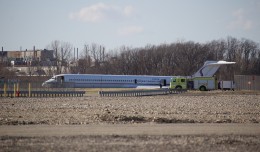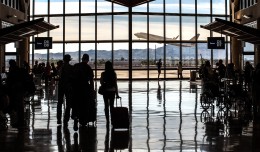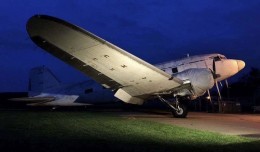Prior to commercial airline deregulation in 1978, airlines typically flew twin-engine, piston-powered interstate aircraft, as well as four-engine intercontinental jet airliners. The traveling public living in smaller cities had limited choices, and would often have to fly multiple carriers when traveling to foreign destinations.
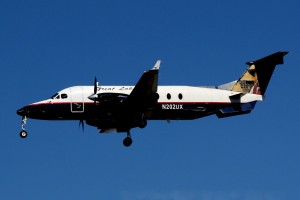
Today, the use of small turboprops is primarily confined to short routes and small cities. Photo by Ben Granucci
In the 1980’s, airlines rapidly expanded their domestic networks. With the blessing of the pilot unions, the service to smaller communities was outsourced to regional carriers under the guise of “Express,” “Connection” or “Commuter.” Although the public was traveling on multiple airlines, the tickets and service were all under the operation the one operator.
The following decade, Bombardier of Canada and Embraer of Brazil introduced 50-seat regional jets. Although these aircraft had far higher operating costs than the turboprops, they quickly replaced them in response to the public demand. The pilot unions, focusing on larger equipment, and thus pay, permitted the regional flying to be continued to be outsourced, but with limitations. These limits included such metrics as number of aircraft, number of seats, and percentage of flying. The term for this these restrictions is “scope”.
Tough Times
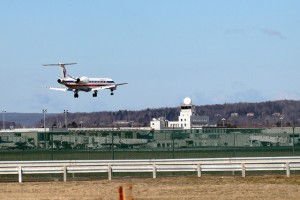
An Embraer Regional Jet (ERJ) operated by American Eagle lands at Bradley International Airport (BDL) in Connecticut. Photo by Ben Granucci
After the severe slump in air traffic post September 2001, airlines rapidly grounded aircraft requiring more than two flight crew members like the Boeing 727, and aging fuel inefficient aircraft like the Douglas DC-9. Under pressure from the threat of bankruptcy as well as rulings from bankruptcy court judges, airlines were able to lower crew costs by forty percent. They were also able to expand the outsourcing of the regional service. The number of airframes and seats permitted under the renegotiated union contracts rapidly expanded, and scope became the line in the sand that moved on an annual basis.
Airlines cited the low operating costs of these regional jets as a necessity to compete with the rapidly expanding low cost carriers. Indeed, the crew costs at these outsourced carriers was half of that of the even recently renegotiated wages of their in-house crews.
One of the most important figures in airline management is Cost per Available Seat Mile, or CASM. Low cost carriers routinely had CASM figures one quarter or more less than traditional or legacy U.S. carriers. Prior to September 2001, customers were quite willing to pay the premium to fly with one of the legacy carriers, but after September 2001, customers became far more cost conscious, and the service differentiation between the low cost carriers and the legacy carriers narrowed.
To compete with low cost carriers, several legacy carriers experimented with internal low cost operations both prior to and post September 2001. Although some of the aspects of these operations were later incorporated to regular operations, these experiments as a whole failed.
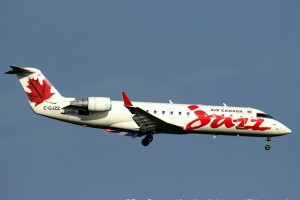
At JFK, an airport known for being served by large jets from around the world, Air Canada’s service today is almost exclusively provided by 50-seat CRJ-200s. Photo by Ben Granucci
The CASM for most outsourced regional operations was reported to be similar to that of the low cost carriers. This provided the justification for the replacement of legacy service as well as the expansion of service, both to new and existing destinations with these new fifty seat regional jets. The RJ revolution was considered a success, and today as much as nearly half of the domestic departures at legacy airlines may be on regional jets. A roundtrip flight connecting through a carrier’s hub might be conducted on four different airlines, none of which directly operated by the carrier who bears the name on the ticket.
Airline pilot unions have seen scope restrictions greatly reduced in the last decade. Currently, regional jets may have up to ninety seats, and there are few restrictions on the amount of turboprop and fifty seat jets that may be done by outside contractors. The unions representing the pilots at legacy carriers have seen their pay and their numbers cut nearly in half. Several union contracts are currently in negotiation, and several more will soon be entering talks. The unions are demanding that there should be no further relaxing of scope restrictions, and may even demand a reduction in the current amount of outsourced flying to regional carriers.
And this is one time when management should listen to labor.
Dollar Dollar Bills, Y’all
The contracts negotiated by regional carriers with the legacy carriers provide a guaranteed source of revenue: Regional carriers are paid a fixed rate regardless of the number of passengers carried, the amount of fuel burned, or even level of service provided. The ticketing, fuel, baggage and other associated costs are all borne by the legacy carrier, leaving the regional carrier to focus solely on the flight itself.
The CASM for regional jet service was widely reported to be far less than that of the legacy service it replaced or augmented. But for some regional carriers, the CASM was as much as half again higher than the legacy carriers they served. These regional carriers generally did have higher labor costs, but the reason for these high costs was that they included peripheral costs, most notably fuel.
Quarterly business reports from airlines that employ the services of regional carriers commonly report a consolidated CASM, a CASM specific to the carrier’s own flight operations, and the CASM for the regional service that does not include fuel. Calculating a CASM for regional service that does include fuel can be calculated with data provided in the quarterly reports. In some quarters, the carriers have also elected to report this figure directly. The CASM for regional service for these carriers, including fuel, is typically fifty percent higher than the carrier’s own service.
Though the cost of providing regional service is high, it had be justified by the revenue it created. Reviewing quarterly reports, one finds that the Revenue per Available Seat Mile, or RASM versus the CASM can be much higher than that at the carrier’s own operations. This is evident in the high ticket prices in communities that are served exclusively by regional carriers.
But the strength of a carrier utilizing vast amounts regional service may soon become a carrier’s Achilles heal.
Paying at the Pumps

With too much fuel and too many passengers onboard to takeoff safely, this American Eagle ERJ heads to the “penalty box” at BDL to burn off some fuel. Photo by Ben Granucci
For most of airline history, the cost of fuel was not a high priority. Like diesel, jet fuel had a low demand and a corresponding low cost. During the last decade, diesel has rapidly replaced gasoline as an automotive fuel source worldwide, and the prices have correspondingly increased. With the explosion of air travel worldwide, jet fuel has also witnessed an increased demand and price. Labor had been historically the largest expense for an airline, but now fuel is typically a carrier’s largest single expense.
Air carriers have been replacing older fuel inefficient aircraft with modern aircraft burning as much as sixty percent less fuel. The carriers also have undertaken projects to reduce fuel burns and incorporated them into their operations. The pilots of these carriers have also had a vested interest in reducing their employer’s fuel costs.
The fuel provided to regional carriers is entirely paid for by the legacy carriers that engage their services. Since this economic pressure is all but eliminated from the regional carriers, the desire for fuel efficiency is greatly diminished. In addition, the regional jets flown at these outsourced carriers have similar fuel burn rates (per available seat mile) to the aging aircraft retired by the airlines in the last ten years. This aspect became evident when fuel prices spiked in 2008.
Limited Operations, Limited Revenue
Another problem faced by carriers utilizing the services of regional jets are the operational abilities, which are limited compared to the legacy carrier’s own equipment. Often these aircraft have limitations on the amount of weight that can be safely and legally be carried. As a result, passengers, cargo, or baggage may be left behind in order to abide the weight restrictions. During deteriorating weather conditions, excess fuel that must be carried further reduces the payload capabilities of these aircraft. Oversold aircraft may leave the gate with as much as fifteen percent of the seats vacant. These regional aircraft are also more likely to cancel when visibility at the destination deteriorates; larger aircraft and their crews are typically certified to land in visibilities less than one quarter mile, whereas the regional service is typically limited to one half mile of visibility. The increased costs of the payload restrictions, as well as the loss of customer service is a hidden cost not reported in a carrier’s quarterly report.
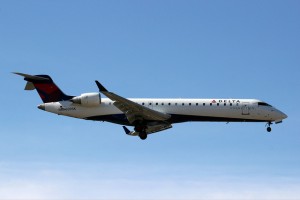
With such poor CASM for 50-seat regional jets, many carriers are opting for larger jets with less frequency. This CRJ-700 is one of the types that carriers are turning to. Photo by Ben Granucci
After the downturn of airline travel in late 2001 and 2008, airlines were able to reduce capacity by parking aircraft and laying off employees. Capacity at some carriers shrunk by nearly one half, replaced in part by contracting with regional carriers. The freedom to now rapidly downsize is limited by these contracts.
Carriers with large outsourced regional operations could be in a precarious situation. A spike in fuel prices will have a greater effect on them, and an economic downturn could saddle them with the inability to easily shed the contracts of these regional carriers. Their service at smaller communities is also vulnerable, for if another carrier with larger aircraft enters this regional market, it could decimate ticket sales with the lower CASM on equipment more desirable to the traveling public.
The effort to expand service and limit costs in the last ten years with regional jets has been highly successful, but the benefits may not be benevolent. The costs and risks of outsourcing continue to rise, and both may limit a carrier’s profits and control. Carriers without the large outsourced flight operations have generally seen better and more consistent revenue. The shift to regional jet flying in the last decade was critical to the survival of the legacy carriers, but it is now becoming the Edsel of air travel.





